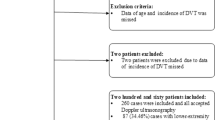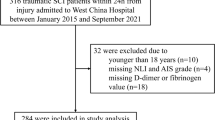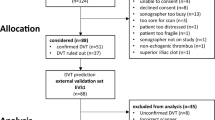Abstract
Objectives
The development of venous thromboembolism (VTE) is a common complication following spinal cord injury (SCI) and brain injury (BI), leading to significant morbidity and mortality. The purpose of this study was to explore the incidence of VTE in patients with the dual diagnosis (DD) of SCI and concomitant BI using ultrasonography.
Design
Retrospective study.
Setting
Acute rehabilitation hospital.
Participants
Thirty-one individuals admitted for DD rehabilitation who were routinely screened for VTE with ultrasound on admission.
Interventions
Not applicable.
Main Outcome Measures
Retrospective chart review was performed to identify whether patients were found to have DVT or PE at the following three time points: in acute care prior to admission to rehabilitation, at time of admission diagnosed via screening examination, and after admission to rehabilitation during the inpatient stay via post screening examinations. Retrospective chart review was also performed to identify incidence of bleeding.
Results
67.7% of individuals were found to have DVTs at any timepoint. Of these DVTs, 22.6% were identified in acute care, 48.4% on admission to rehabilitation, and 16.1% during the course of rehabilitation stay. Of those who were placed on therapeutic anticoagulation due to admission diagnosis of VTE, 25% developed recurrent DVT and 12.5% had bleeding complications. No cases of PE were observed in this study population.
Conclusions
This study found a high incidence of DVT for the DD population at all three timepoints with a high proportion identified via screening ultrasonography on admission to rehabilitation. Further research is needed to investigate the incidence of VTE and utility of screening ultrasonography in this population.
Similar content being viewed by others
Log in or create a free account to read this content
Gain free access to this article, as well as selected content from this journal and more on nature.com
or
Data availability
Data are available upon request from the corresponding author.
References
Geerts WH, Code KI, Jay RM, Chen E, Szalai JP. A prospective study of venous thromboembolism after major trauma. N Engl J Med. 1994;331:1601–6.
Phelan HA, Wolf SE, Norwood SH, Aldy K, Brakenridge SC, Eastman AL, et al. A randomized, double-blinded, placebo-controlled pilot trial of anticoagulation in low-risk traumatic brain injury: The Delayed Versus Early Enoxaparin Prophylaxis I (DEEP I) study. J Trauma Acute Care Surg. 2012;73:1434–41.
Mirkowski M, Harnett A, McIntyre A, Hsieh J, Loh E, Teasell R. Spinal cord injury rehabilitation evidence: venous thromboembolism following spinal cord injury. In: SCIRE. 2020.
Prevention of Venous Thromboembolism in Individuals with Spinal Cord Injury. Clinical practice guidelines for health care providers, 3rd ed.: consortium for spinal cord medicine. Top Spinal Cord Inj Rehabil. 2016;22:209–40.
Dudley RR, Aziz I, Bonnici A, Saluja RS, Lamoureux J, Kalmovitch B, et al. Early venous thromboembolic event prophylaxis in traumatic brain injury with low-molecular-weight heparin: risks and benefits. J Neurotrauma. 2010;27:2165–72.
Draganich C, Park A, Sevigny M, Charlifue S, Coons D, Makley M, et al. Venous thromboembolism: Exploring incidence and utility of screening in spinal cord injury. J Spinal Cord Med. 2023;10:1–8.
Rivas L, Vella M, Ju T, Fernandez-Moure JS, Sparks A, Seamon MJ, et al. Early chemoprophylaxis against venous thromboembolism in patients with traumatic brain injury. Am Surg. 2021;88:000313482098317.
Draganich C, Park A, Sevigny M, Charlifue S, Coons D, Makley M, et al. Venous thromboembolism: Exploring incidence and utility of screening in individuals with brain injury. Arch Phys Med Rehabil. 2023;104:S0003999323000874.
Rogers FB, Cipolle MD, Velmahos G, Rozycki G, Luchette FA. Practice management guidelines for the prevention of venous thromboembolism in trauma patients: the EAST Practice Management Guidelines Work Group. J Trauma Inj Infect Crit Care. 2002;53:142–64.
Denson K, Morgan D, Cunningham R, Nigliazzo A, Brackett D, Lane M, et al. Incidence of venous thromboembolism in patients with traumatic brain injury. Am J Surg. 2007;193:380–4.
Ortel TL, Neumann I, Ageno W, Beyth R, Clark NP, Cuker A, et al. American Society of Hematology 2020 guidelines for management of venous thromboembolism: treatment of deep vein thrombosis and pulmonary embolism. Blood Adv. 2020;4:4693–738.
Gruen GS, McClain EJ, Gruen RJ. The diagnosis of deep vein thrombosis in the multiply injured patient with pelvic ring or acetabular fractures. Orthopedics. 1995;18:253–7.
Yablon SA, Rock WA, Nick TG, Sherer M, McGrath CM, Goodson KH. Deep vein thrombosis: prevalence and risk factors in rehabilitation admissions with brain injury. Neurology. 2004;63:485–91.
Ekeh AP, Dominguez KM, Markert RJ, McCarthy MC. Incidence and risk factors for deep venous thrombosis after moderate and severe brain injury. J Trauma Inj Infect Crit Care. 2010;68:912–5.
Hoffman H, Jalal MS, Chin LS. The risk factors, outcomes, and costs associated with venous thromboembolism after traumatic brain injury: a nationwide analysis. Brain Inj. 2019;33:1671–8.
Schellong SM, Beyer J, Kakkar AK, Halbritter K, Eriksson BI, Turpie AGG, et al. Ultrasound screening for asymptomatic deep vein thrombosis after major orthopaedic surgery: the VENUS study. J Thromb Haemost. 2007;5:1431–7.
Acknowledgements
We would like to acknowledge the Craig Hospital Foundation and the patients, families, and staff who participated in this study.
Funding
This work was supported by the Craig Hospital Foundation under grant number 2643.
Author information
Authors and Affiliations
Contributions
CD was responsible for study design, extracting the data, interpreting study results, and writing the report. AP was responsible for study design, interpreting study results, and writing the report. MS was responsible for analyzing data, interpreting results, and writing the report. SC was responsible for extracting the data and writing the report. MM was responsible for interpreting study results and writing the report. DC was responsible for interpreting study results and writing the report. RA was responsible for study design and writing the report. JF was responsible for study design and writing the report. JB was responsible for study design, extracting the data, interpreting study results, and writing the report.
Corresponding author
Ethics declarations
Competing interests
The authors declare no competing interests.
Ethics approval and consent to participate
This study was in accordance with the Declaration of Helsinki. This study was approved by the hospital institutional review board. Informed consent was not obtained as this was a retrospective review.
Additional information
Publisher’s note Springer Nature remains neutral with regard to jurisdictional claims in published maps and institutional affiliations.
Rights and permissions
Springer Nature or its licensor (e.g. a society or other partner) holds exclusive rights to this article under a publishing agreement with the author(s) or other rightsholder(s); author self-archiving of the accepted manuscript version of this article is solely governed by the terms of such publishing agreement and applicable law.
About this article
Cite this article
Draganich, C., Park, A., Sevigny, M. et al. Venous thromboembolism: exploring incidence and utility of screening in individuals with dual diagnosis. Spinal Cord Ser Cases 10, 58 (2024). https://doi.org/10.1038/s41394-024-00670-1
Received:
Revised:
Accepted:
Published:
DOI: https://doi.org/10.1038/s41394-024-00670-1



